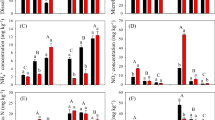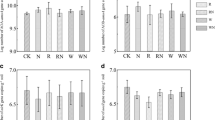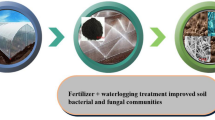Abstract
Purpose
Sampling and analysis of greenhouse soils were conducted in Shouguang, China, to study continuous excessive fertilization effect on nitrifying microbial community dynamics in greenhouse environment.
Materials and methods
Potential nitrification activity (PNA), abundance, and structure of nitrifying microbial communities as well as the correlations with soil properties were investigated.
Results and discussion
Short-term excessive fertilization increased soil nutrient contents and the diversity of nitrifying microbial communities under greenhouse cultivation. However, the abundance and diversity of nitrifying communities decreased greatly due to the increase of soil acidity and salinity after 14 years of high fertilization in greenhouse. There was a significant positive correlation between soil PNA and the abundance of ammonia-oxidizing bacteria (AOB) but not that of ammonia-oxidizing archaea (AOA) in topsoil (0–20 cm) when pH ≥7. Soil PNA and AOB were strongly influenced by soil pH. The groups of Nitrososphaeraceae, Nitrosomonadaceae, and Nitrospiraceae were predominant in the AOA, AOB, and nitrite-oxidizing bacteria (NOB) communities, respectively. Nitrifying community structure was significantly correlated with soil electrical salinity (EC), organic carbon (OC), and nitrate nitrogen (NO3 −–N) content by redundancy analysis (RDA).
Conclusions
Nitrification was predominated by AOB in greenhouse topsoil with high fertilizer loads. Soil salinity, OC, NO3 −–N content, and pH affected by continuous excessive fertilization were the major edaphic factors in shaping nitrifying community structure in greenhouse soils.




Similar content being viewed by others
References
Ai C, Liang GQ, Sun JW, Wang XB, He P, Zhou W (2013) Different roles of rhizosphere effect and long-term fertilization in the activity and community structure of ammonia oxidizers in a calcareous fluvo-aquic soil. Soil Biol Biochem 57:30–42
Bao SD (2000) Soil agro-chemical analyses. Chinese Agricultural Press (in Chinese), Beijing
Bissett A, Abell GC, Brown M, Thrall PH, Bodrossy L, Smith MC, Baker GH, Richardsson AE (2014) Land-use and management practices affect soil ammonia oxidiser community structure, activity and connectedness. Soil Biol Biochem 78:138–148
Bock E, Wagner M (2006) Oxidation of inorganic nitrogen compounds as an energy source. In the prokaryotes. Springer, New York, pp. 457–495
Chu HY, Fujii T, Morimoto S, Lin XG, Yagi K (2008) Population size and specific nitrification potential of soil ammonia-oxidizing bacteria under long-term fertilizer management. Soil Biol Biochem 40(7):1960–1963
De Boer W, Kowalchuk GA (2001) Nitrification in acid soils: micro-organisms and mechanisms. Soil Biol Biochem 33(7):853–866
De Gannes V, Eudoxie G, Hickey WJ (2014) Impacts of edaphic factors on communities of ammonia-oxidizing archaea, ammonia-oxidizing bacteria and nitrification in tropical soils. PLoS One 9(2):e89568
Di HJ, Cameron KC, Shen JP, Winefield CS, O’Callaghan M, Bowatte S, He JZ (2010) Ammonia-oxidizing bacteria and archaea grow under contrasting soil nitrogen conditions. FEMS Microbiol Ecol 72:386–394
Erguder TH, Boon N, Wittebolle L, Marzorati M, Verstraete W (2009) Environmental factors shaping the ecological niches of ammonia oxidizing archaea. FEMS Microbiol Rev 33:855–869
Fan FL, Yang QB, Li ZJ, Wei D, Cui XA, Liang YC (2011) Impacts of organic and inorganic fertilizers on nitrification in a cold climate soil are linked to the bacterial ammonia oxidizer community. Microb Ecol 62(4):982–990
Francis CA, Beman JM, Kuypers MM (2007) New processes and players in the nitrogen cycle: the microbial ecology of anaerobic and archaeal ammonia oxidation. ISME J 1(1):19–27
Freitag TE, Chang L, Clegg CD, Prosser JI (2005) Influence of inorganic nitrogen management regime on the diversity of nitrite-oxidizing bacteria in agricultural grassland soils. Appl Environ Microbiol 71(12):8323–8334
French E, Kozlowski JA, Mukherjee M, Bullerjahn G, Bollmann A (2012) Ecophysiological characterization of ammonia-oxidizing archaea and bacteria from freshwater. Appl Environ Microbiol 78(16):5773–5780
Guo JH, Liu XJ, Zhang Y, Shen JL, Han WX, Zhang WF, Christie P, Goulding KWT, Vitousek PM, Zhang FS (2010) Significant acidification in major Chinese croplands. Science 327(5968):1008–1010
Han JP, Luo YH, Yang LP, Liu XM, Wu LS, Xu JM (2014) Acidification and salinization of soils with different initial pH under greenhouse vegetable cultivation. J Soils Sediments 14(10):1683–1692
Han JP, Shi JC, Zeng LZ, Xu JM, Wu LS (2015) Effects of nitrogen fertilization on the acidity and salinity of greenhouse soils. Environ Sci Pollut Res 22(4):2976–2986
Ju XT, Kou CL, Zhang FS, Christie P (2006) Nitrogen balance and groundwater nitrate contamination: comparison among three intensive cropping systems on the North China plain. Environ Pollut 143(1):117–125
Kingery WL, Wood CW, Delaney DP, Williams JC, Mullins GL (1994) Impact of long-term land application of broiler litter on environmentally related soil properties. J Environ Qual 23(1):139–147
Könneke M, Bernhard AE, José R, Walker CB, Waterbury JB, Stahl DA (2005) Isolation of an autotrophic ammonia-oxidizing marine archaeon. Nature 437(7058):543–546
Kowalchuk GA, Stephen JR (2001) Ammonia-oxidizing bacteria: a model for molecular microbial ecology. Annu Rev Microbiol 55(1):485–529
Kurola J, Salkinoja-Salonen M, Aarnio T, Hultman J, Romantschuk M (2005) Activity, diversity and population size of ammonia-oxidizing bacteria in oil-contaminated land farming soil. FEMS Microbiol Lett 250(1):33–38
Leininger S, Urich T, Schloter M, Schwark L, Qi J, Nicol GW, Prosser JI, Schuster SC, Schleper C (2006) Archaea predominate among ammonia-oxidizing prokaryotes in soils. Nature 442(7104):806–809
Ma Y, Zhang Z (2013) Rethinking on vegetable industry mode in Shouguang. Hunan Agric Sci 15:136–138 in Chinese
Martens-Habbena W, Berube PM, Urakawa H, De La Torre JR, Stahl DA (2009) Ammonia oxidation kinetics determine niche separation of nitrifying archaea and bacteria. Nature 461(7266):976–979
Nicol GW, Leininger S, Schleper C, Prosser JI (2008) The influence of soil pH on the diversity, abundance and transcriptional activity of ammonia oxidizing archaea and bacteria. Environ Microbiol 10(11):2966–2978
O’Sullivan CA, Wakelin SA, Fillery IR, Roper MM (2013) Factors affecting ammonia-oxidising microorganisms and potential nitrification rates in southern Australian agricultural soils. Soil Res 51(3):240–252
Reigstad LJ, Richter A, Daims H, Urich T, Schwark L, Schleper C (2008) Nitrification in terrestrial hot springs of Iceland and Kamchatka. FEMS Microbiol Ecol 64:167–174
Rocca JD, Hall EK, Lennon JT, Evans SE, Waldrop MP, Cotner JB, Nemergut DR, Graham EB, Wallenstein MD (2015) Relationships between protein-encoding gene abundance and corresponding process are commonly assumed yet rarely observed. ISME 9:1693–1699
Shen JP, Zhang LM, Zhu YG, Zhang JB, He JZ (2008) Abundance and composition of ammonia-oxidizing bacteria and ammonia-oxidizing archaea communities of an alkaline sandy loam. Environ Microbiol 10(6):1601–1611
Shen W, Lin X, Gao N, Shi W, Min J, He X (2011) Nitrogen fertilization changes abundance and community composition of ammonia-oxidizing bacteria. Soil Sci Soc Am J 75(6):2198–2205
Shen JP, Zhang LM, He JZ (2014) Contrasting response of nitrification capacity in three agricultural soils to N addition during short-term incubation. J Soils Sediments 14(11):1861–1868
Song H, Che Z, Cao W, Huang T, Wang J, Dong Z (2016) Changing roles of ammonia-oxidizing bacteria and archaea in a continuously acidifying soil caused by over-fertilization with nitrogen. Environ Sci Pollut Res 23(12):11964–11974
Suzuki I, Dular U, Kwok SC (1974) Ammonia or ammonium ion as substrate for oxidation by Nitrosomonas europaea cells and extracts. J Bacteriol 120(1):556–558
Verhamme DT, Prosser JI, Nicol GW (2011) Ammonia concentration determines differential growth of ammonia-oxidising archaea and bacteria in soil microcosms. ISME J 5(6):1067–1071
Walker CB, De La Torre JR, Klotz MG, Urakawa H, Pinel N, Arp DJ, Brochier-Armanet C, Chain PSG, Chan PP, Gollabgir A, Hemp J, Hügler M, Karr EA, Könneke M, Shin M, Lawton TJ, Lowe T, Martens-Habbena W, Sayavedra-Soto LA, Lang D, Sievert SM, Rosenzweig AC, Manning G, Stahl DA (2010) Nitrosopumilus maritimus genome reveals unique mechanisms for nitrification and autotrophy in globally distributed marine crenarchaea. PNAS 107(19):8818–8823
Wang YF, Gu JD (2014) Effects of allylthiourea, salinity, and pH on ammonia/ammonium-oxidizing prokaryotes in mangrove sediment incubated in laboratory microcosms. Appl microbiol biot 98(7):3257–3274
Wang Y, Ke X, Wu L, Lu Y (2009) Community composition of ammonia-oxidizing bacteria and archaea in rice field soil as affected by nitrogen fertilization. Syst Appl Microbiol 32(1):27–36
Wang B, Zhao J, Guo Z, Ma J, Xu H, Jia Z (2014) Differential contributions of ammonia oxidizers and nitrite oxidizers to nitrification in four paddy soils. ISME J 9:1062–1075
Xia W, Zhang C, Zeng X, Feng Y, Weng J, Lin X, Zhu J, Xiong Z, Xu J, Cai Z, Jia Z (2011) Autotrophic growth of nitrifying community in an agricultural soil. ISME J 5(7):1226–1236
Xiao R, Chen B, Liu Y, Wang C, Gu JD, Feng H, Du G, Ma X (2014) Higher abundance of ammonia oxidizing archaea than ammonia oxidizing bacteria and their communities in Tibetan alpine meadow soils under long-term nitrogen fertilization. Geomicrobiol J 31(7):597–604
Xie Z, Le Roux X, Wang C, Gu Z, An M, Nan H, Chen B, Li F, Liu Y, Du G, Feng H, Ma X (2014) Identifying response groups of soil nitrifiers and denitrifiers to grazing and associated soil environmental drivers in Tibetan alpine meadows. Soil Biol Biochem 77:89–99
Xu YG, Yu WT, Ma Q, Zhou H (2012) Responses of bacterial and archaeal ammonia oxidisers of an acidic luvisols soil to different nitrogen fertilization rates after 9 years. Biol Fert Soils 48(7):827–837
Yao H, Gao Y, Nicol GW, Campbell CD, Prosser JI, Zhang L, Han W, Singh BK (2011) Links between ammonia oxidizer community structure, abundance, and nitrification potential in acidic soils. Appl Environ Microbiol 77(13):4618–4625
Zeglin LH, Taylor AE, Myrold DD, Bottomley PJ (2011) Bacterial and archaeal amoA gene distribution covaries with soil nitrification properties across a range of land uses. Env Microbiol Rep 3(6):717–726
Zeng XB, Bai LY, Su SM, Li LF (2010) Acidification and salinization in greenhouse soil of different cultivation years from Shouguang City, Shandong. Acta Ecol Sin 30(7):7 in Chinese
Zhang LM, He JZ (2012) A novel archaeal phylum: Thaumarchaeota—a review. Acta Microbiol Sin 52(4):411–421 in Chinese
Zhang LM, Hu HW, Shen JP, He JZ (2011) Ammonia-oxidizing archaea have more important role than ammonia-oxidizing bacteria in ammonia oxidation of strongly acidic soils. ISME J 6(5):1032–1045
Zhao S, Qiu S, Cao C, Zheng C, Zhou W, He P (2014) Responses of soil properties, microbial community and crop yields to various rates of nitrogen fertilization in a wheat–maize cropping system in north-Central China. Agric Ecosyst Environ 194:29–37
Zhou JB, Chen ZJ, Liu XJ, Zhai BN, Powlson DS (2010) Nitrate accumulation in soil profiles under seasonally open ‘sunlight greenhouses’ in Northwest China and potential for leaching loss during summer fallow. Soil Use Manage 26(3):332–339
Acknowledgments
This work was jointly supported by the National Key Technology Support Program (2014BAD14B04), the National Basic Research Program of China (2011CB100502), and the National Natural Science Foundation of China (41571450, 41271470, 41571215).
Author information
Authors and Affiliations
Corresponding authors
Additional information
Responsible editor: Yanfen Wang
Rights and permissions
About this article
Cite this article
Han, J., Shi, J., Zeng, L. et al. Impacts of continuous excessive fertilization on soil potential nitrification activity and nitrifying microbial community dynamics in greenhouse system. J Soils Sediments 17, 471–480 (2017). https://doi.org/10.1007/s11368-016-1525-z
Received:
Accepted:
Published:
Issue Date:
DOI: https://doi.org/10.1007/s11368-016-1525-z




